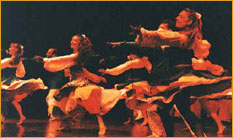|
>
Article published first in judaism.about.com Since Biblical times, the Jewish people have expressed joy through dance. Throughout the centuries, dance has become a part of religious, communal, and family celebrations. Modern Israeli dancing can be categorized in two genres. Folk dancing was brought to Israel by the early settlers. Art Dance has developed as a cultural activity with stage productions, created by professional choreographers and performed by trained dancers. Israeli Folk Dance
While originally from Europe, Israeli folk dance has been influenced by the traditional dances of different ethnic groups in Israel. Many dances are choreographed to modern Israeli music, which is a blend of western and middle eastern culture. Today Israeli folk dancing is done around the world - in Israel, Europe, South America, United States, Canada, Australia, and even Japan. Thousands of people participate in Israeli dance classes as a recreational outlet. In addition, folk dance troupes perform at festivals and events throughout the year. Israeli Art Dance
Batsheva Dance Company, founded in 1964 by Batsheva de Rothschild, is considered Israel's leading contemporary dance company. The style of this ensemble was originally influenced by Martha Graham, but today its dances are influenced by current choreographers and the company's own artistic director, Ohad Naharin. The Bat-Dor Dance Company, was founded in 1967 by Batsheva de Rothschild and Jeannette Ordman, its artistic director. There are about 20 dancers in this group, and they perform dances of some of the world's best choreographers. Kibbutz Contemporary Dance Company, founded in 1967, consists of about 15 dancers from different kibbutzim and is based in the northern Galilee. Their artistic director, Yehudit Arnon, has the group perform dances of both local and international choreographers. The group also specializes in performances for young audiences. The Israel Ballet, founded in 1968, is the country's only professional classical ballet company. Many new immigrant dancers from the former Soviet Union have joined the Israeli Ballet. The group's artistic directors are Berta Yampolsky and Hillel Markman. Kol U'Demama (Sound and Silence), founded in 1978 by Moshe Efrati, has both deaf and hearing dancers. The company has acquired an international reputation both for its artistic merit and for its contribution to the rehabilitation of hearing impaired.
home | introduction | articles
Copyright ©
All Rights Reserved.
|
|


